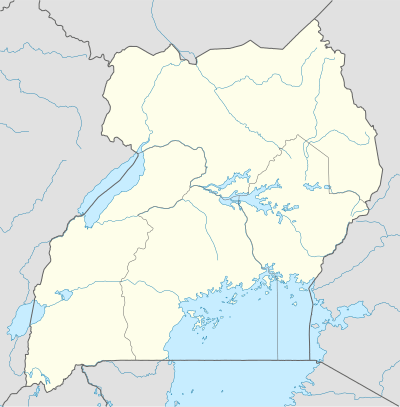Bidi Bidi Refugee Settlement
| Bidibidi Refugee Settlement | |
|---|---|
 Bidibidi Refugee Settlement | |
| Coordinates: 3°32′N 31°21′E / 3.53°N 31.35°ECoordinates: 3°32′N 31°21′E / 3.53°N 31.35°E | |
| Country | Uganda |
| District | Yumbe |
| Area[1] | |
| • Total | 250 km2 (100 sq mi) |
Bidibidi Refugee Settlement is a refugee camp in northwestern Uganda. With over 270,000 South Sudanese refugees fleeing the ongoing civil war, as of early 2017 it is the largest refugee settlement in the world.[2][1]
Geography
Bidibidi covers 250 square kilometers of the eastern half of the district of Yumbe, stretching southward from the South Sudanese border and spilling over into Moyo District along the western bank of the Kochi River.[3]
History
Bidibidi was a small village before becoming a refugee settlement which was opened in August 2016.[4][5]
Health
There have been growing concerns about health conditions and access to health services as the number of South Sudan refugees entering Uganda continues to increase, with Reuters reporting that 180 refugees (nearly half of them young children) died in Bidibidi in the first six months of 2017.[6] This is compounded by how there is often limited accuracy of health measurements in camp settings, with under-reporting of deaths by humanitarian organizations typically occurring more frequently than over-reporting of deaths.[7]
From a human rights and ethics perspective, there are also questions about whether people with different physical abilities or the elderly are de-prioritized in these settlements, receiving less resources compared to younger, able-bodied residents in good health.[8] In settlements located in the Ayilo District of Northern Uganda, for example, the organization Caritas reports that programs have been designed to provide more assistance for building latrines to groups identified as vulnerable, such as older residents, disabled residents, and child-headed households.
Furthermore, a 2016 U.S. State Department report on trafficking warns that South Sudanese children in Northern Ugandan refugee settlements may be vulnerable to trafficking, with the UNHCR suspecting that instances of trafficking are already occurring among young South Sudanese refugees. Unfortunately, reliably quantifying the number of trafficked children can be a challenge due to lack of effective monitoring, corruption, insufficient protection of victims to come forward, differences in definitions of terms, and other contextual aspects.[9]
References
- 1 2 Biryabarema, Elias (15 December 2016). "Hatred spills beyond South Sudan along with refugees". Reuters. Retrieved 6 April 2017.
- ↑ Hattem, Julian (24 January 2017). "Uganda's sprawling haven for 270,000 of South Sudan's refugees". The Guardian. Retrieved 5 April 2017.
- ↑ "Uganda - Bidibidi camp (as of Feb 2017)". reliefweb. Retrieved 6 April 2017.
- ↑ "As Thousands Flee South Sudan, Ugandan Refugee Camp Becomes World's Largest". NPR. 5 April 2017.
- ↑ "Three months ago, it was a tiny Ugandan village. Now it's the world's fourth-largest refugee camp". The Washington Post. 28 October 2016.
- ↑ Mukasa, Francis. "South Sudanese refugees in Uganda near million mark". U.K. Retrieved 2017-12-04.
- ↑ Spiegel, P. B.; Sheik, M.; Woodruff, B. A.; Burnham, G. (June 2001). "The accuracy of mortality reporting in displaced persons camps during the post-emergency phase". Disasters. 25 (2): 172–180. ISSN 0361-3666. PMID 11434236.
- ↑ Ciottone, Gregory. "Ciottone's Disaster Medicine (Second Edition)".
- ↑ Bhabha, Jacqueline (2014). Child Migration and Human Rights in a Global Age. Princeton University Press. ISBN 9780691143606. JSTOR j.ctt5hhrwz.